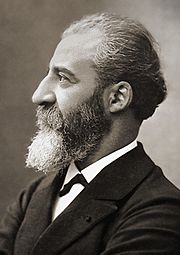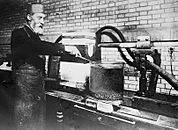Henri Moissan facts for kids
Quick facts for kids
Henri Moissan
|
|
|---|---|

Moissan in 1906
|
|
| Born |
Ferdinand Frédéric Henri Moissan
28 September 1852 Paris, France
|
| Died | 20 February 1907 (aged 54) Paris, France
|
| Nationality | French |
| Known for | Isolation of fluorine |
| Spouse(s) | Marie Léonie Lugan Moissan (m. 1882; 1 child) |
| Awards | Davy Medal (1896) Elliott Cresson Medal (1898) Nobel Prize for Chemistry (1906) |
| Scientific career | |
| Fields | Chemistry |
| Institutions | Sorbonne |
| Doctoral advisor | Henri Debray |
| Doctoral students | Paul Lebeau Maurice Meslans |
| Signature | |
Henri Moissan (born September 28, 1852 – died February 20, 1907) was a famous French chemist and pharmacist. He won the Nobel Prize in Chemistry in 1906. He received this award for being the first person to successfully separate the element fluorine from its compounds. Moissan was also an early member of the International Atomic Weights Committee.
Contents
About Henri Moissan
Early Life and Education
Henri Moissan was born in Paris, France, on September 28, 1852. His father worked for a railway company, and his mother was a seamstress. In 1864, his family moved to Meaux, where Henri became an apprentice clockmaker.
In 1870, his family returned to Paris because of a war. Henri could not go straight to university. After serving a year in the army, he enrolled at the Ecole Superieure de Pharmacie de Paris.
Starting a Science Career
In 1871, Moissan began training as a pharmacist. The next year, he worked for a chemist in Paris. There, he helped save someone who had been poisoned. This experience made him decide to study chemistry.
He studied in the labs of famous chemists like Edmond Frémy and Pierre Paul Dehérain. Dehérain encouraged him to become a scientist. Moissan earned his university entrance exam in 1874. He also became a top pharmacist in 1879 and received his doctorate degree in 1880.
Rise in Academia
Moissan quickly moved up at the School of Pharmacy. He became an Assistant Lecturer, then a Senior Demonstrator. By 1886, he was a Professor of Toxicology. In 1899, he became the Chair of Inorganic Chemistry.
The next year, he became a Professor of Inorganic Chemistry at the Sorbonne. During his time in Paris, he became friends with other scientists. In 1882, he married Léonie Lugan. They had a son named Louis Ferdinand Henri in 1885.
Later Life and Awards
Henri Moissan passed away suddenly in Paris in February 1907. This happened shortly after he returned from receiving his Nobel Prize in Stockholm. His death was caused by a severe case of appendicitis.
During his career, Moissan wrote over 300 scientific papers. Besides the Nobel Prize, he won many other awards. These included the Davy Medal and the Elliott Cresson Medal. He was also chosen as a member of important scientific groups. These included the Royal Society and the International Atomic Weights Committee. He was also made a commandeur in the Légion d'honneur.
Key Discoveries and Research
Moissan's first scientific paper was about how plants use carbon dioxide and oxygen. He wrote it with Dehérain in 1874. After this, he focused on inorganic chemistry. His work on iron that catches fire easily was well-received by other chemists.
Isolating Fluorine
In the 1880s, Moissan focused on the element fluorine. Scientists knew fluorine existed for many years. However, all attempts to separate it had failed. Some experimenters even died trying.
Moissan did not have his own lab. He borrowed space from other scientists. He used a powerful battery with 90 cells. This allowed him to observe a gas made by sending electricity through melted arsenic trichloride.
Moissan finally succeeded in isolating fluorine in 1886. He used a process called electrolysis. He passed electricity through a mixture of potassium hydrogen difluoride and liquid hydrogen fluoride. This mixture was needed because hydrogen fluoride alone does not conduct electricity well.
He used special platinum-iridium electrodes in a platinum holder. The equipment was cooled to a very cold temperature of -50°C. This process completely separated the hydrogen from the fluorine. This happened on June 26, 1886. This method is still used today to produce fluorine for industries.
The French Academy of Science sent three experts to check his results. Moissan had trouble reproducing them at first. This was because a tiny amount of potassium fluoride was missing from his hydrogen fluoride. Once he fixed this, he showed the production of fluorine many times. He was awarded a prize of 10,000 francs. For this amazing discovery, he won the 1906 Nobel Prize in Chemistry.
Further Studies and Inventions
After isolating fluorine, Moissan continued to study its chemistry. He discovered many fluorine compounds. For example, he found sulfur hexafluoride in 1901 with Paul Lebeau.
Moissan also helped develop the electric arc furnace. This special furnace uses electricity to create very high temperatures. It allowed scientists to make new compounds. He tried to use this furnace and high pressure to create synthetic diamonds from carbon.
He also used the furnace to create compounds called borides and carbides. Making calcium carbide was a big achievement. This opened the door for new discoveries in the chemistry of acetylene.
In 1893, Moissan began studying pieces of a meteorite. This meteorite was found near Diablo Canyon in Arizona. In these fragments, he found tiny amounts of a new mineral. After much research, Moissan realized this mineral was made of silicon carbide. In 1905, this mineral was named moissanite in his honor.
In 1903, Moissan became a member of the International Atomic Weights Committee. He served on this committee until his death.
See also
 In Spanish: Henri Moissan para niños
In Spanish: Henri Moissan para niños



